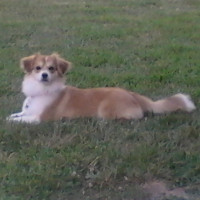Appearance of the Shetinese
|
| The Shetinese hybrid is a mixture of Pekingese and Shetland Sheepdog and, as such, can inherit appearance traits from either or both of its parent breeds. Your Shetinese hybrid may have an average height of 28 centimeters at the shoulders and an average weight of 8 kilos. His coat can be thick and long or double, with a short, soft undercoat and a longer, rougher topcoat. Coat colors can be white, gray, tan, black, brown, red, sable or blue merle. The tail can be set high, carried high and arched over the back, or set high and carried slightly upwards, the tail having a fringe to match the coat. Eyes may be large, round, bold and very dark, or medium-sized, almond-shaped and dark, although blue may be seen in merle-blue dogs. The muzzle can be long or short, with a black nose and a scissor bite or lower bite. |
Temperament of the Shetinese
|
| Your Shetinese hybrid is a mix of Pekinese and Shetland Sheepdog, and may inherit the temperament and personality of one or both parent breeds. Traits it can inherit include aggression, affection, kindness, courage, gentleness and independence. This Shetinese is also known for its intelligence, alertness, affectionate attitude, mischievousness, loyalty and responsiveness. This hybrid can be a little more difficult to train, sometimes showing a certain stubbornness. He's friendly if properly socialized at a young age to ensure that he'll get on well enough with children, the family cat and other dogs. He will be friendly with strangers if properly socialized, but expect him to be wary until he feels there is no danger to members of his human family. It's important to bear in mind that the Sheltie's parents have a strong herding instinct, so he may inherit enough of a herding instinct to “herd” the family's children, cat or dog. It can be a frequent barker, an important characteristic for those living in noise-restricted areas. |
Needs and activities of the Shetinese
|
| Your Shetinese hybrid is an active little companion who will need 1 to 2 hours of daily exercise to stay fit, healthy and happy. This exercise can take the form of several walks or jogs, playing in a dog park or fenced yard, interactive games such as fetch, Frisbee, flyball, agility training and obedience training. He has a strong urge to hunt and a moderate tendency to roam, so it's very important to keep him on a leash when you take him out of the house, fenced yard or other secure enclosure, unless you like to chase him through brambles and heather in pursuit of a small animal or an interesting scent that has caught his eye. Its small to medium size makes it a perfect dog for apartment or condominium living, provided it has sufficient opportunities for exercise and there are no noise pollution problems in these areas. He can also live very well in a family home with or without a fenced yard, in an urban or rural environment. It can tolerate colder as well as moderately warm temperatures, bearing in mind that it may need extra protection in extreme temperatures. |
Maintenance of the Shetinese
|
| Your Shetinese hybrid falls into the category of high-maintenance dogs, mainly due to the length and thickness of its coat, which is not hypoallergenic. It has moderate/seasonal shedding, requiring brushing several times a week, and daily brushing during periods of seasonal shedding. He should only be bathed when necessary, to avoid drying out the vital oils in his coat. These dogs are classified as high-moderate hunting dogs and moderate wandering dogs. It is therefore important to keep him on a leash when he is away from home or fenced property. He is classified in the low category for drooling and dog odor. His ears should be checked weekly and cleaned if necessary with absorbent cotton and a cleaning product approved for canine ears. While you're checking his ears, take a look at his nails and trim them if necessary, unless he's able to maintain them during normal daily activities. Be sure to brush his teeth at home at least two to three times a week to prevent the development of periodontal disease and subsequent tooth loss. |









 English (United Kingdom)
English (United Kingdom)